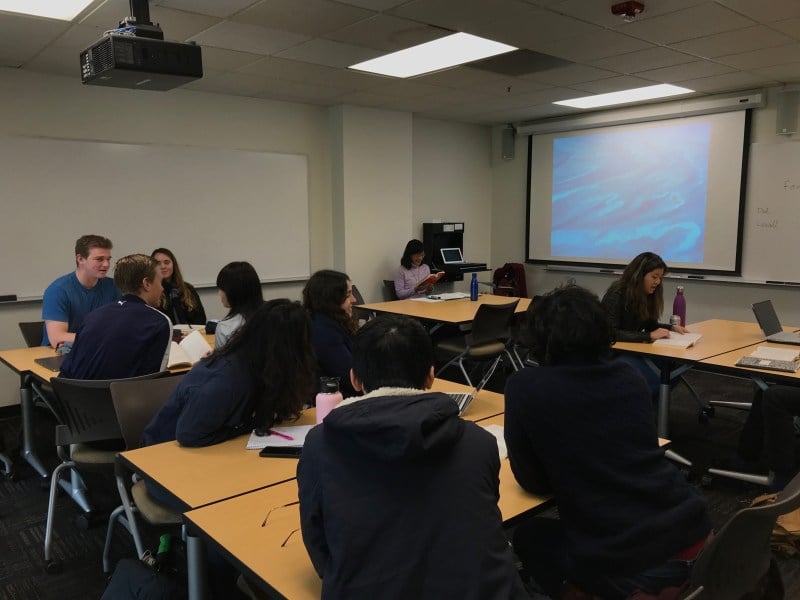Designed as a cross-cultural comparative course, CHINA 70N: “Animal Planet and the Romance of the Species,” was offered the winter quarter of 2019. A freshman introductory seminar (IntroSem) taught by Haiyan Lee, professor of East Asian Languages and Cultures and of comparative literature, CHINA 70N approaches human-animal relationships through analysis of the similarities and differences between Chinese and Western characterizations of animals.
“We started the class with Chinese tales of foxes and monkeys, and oftentimes the animals are kind of a conduit to the supernatural realm or to the gods,” Lee said. “When we come to European stories or American stories, there seems to be kind of an insuperable gulf between humanity and animality.”
According to Lee, many students in CHINA 70N come from diverse backgrounds that allow for unique comparisons across different cultures and societies.
“I think this class is really interesting and gives you a sense of not just the ways to think about animals in the typical sense, in terms of animal rights, but also how we classify different animals on a spectrum,” Stephanie Houck ’22 said. “[In class] we also talked about anthropomorphizing animals, [or] what kinds of different animals portray different human traits, which I think is really interesting in how we make those connections.”
CHINA 70N is a reading- and discussion-based course. Lee, who first developed the course in her second year at Stanford in 2010, emphasized the advantages of its seminar-style structure.
“The format of a freshman seminar is ideally suited to this topic,” she said. “Students have a lot to say, and this seminar format really encourages them to share their experiences … most of them have had experiences living with animals, and they bring up very interesting stories from their own lives.”
The class uses humanistic-interpretive, sociological and philosophical approaches to consider the difficulty of achieving consistency in human relationships with animals.
“We, of course, treat some animals as family — our pets we love and cherish — but we treat other animals as tools, as sources of food and clothes and nutrition and … labor power or test subjects or entertainment as we go to the zoo,” Lee said. “And we’re not ready, in fact, to give up all these things yet.”
In the middle of the quarter, the class takes a field trip to the San Francisco Zoo. There, students record their observations and interview people at the zoo. Their investigations later culminate in a group project and presentation, connecting themes of the scholarly literature they have read with the presentation of animals in the zoo.
Additionally, students must write either a conventional academic paper at the end of the quarter, or two creative “fanfiction” stories, one in the middle and one in the end of the term. The fanfictions provide a “twist” to a story or particular episode that students have read. About two-thirds of the students choose the fanfiction option each year, Lee said, as it allows them to further engage the texts from class in an empathic manner.
In the last two weeks of the course, students read Karen Joy Fowler’s novel “We Are All Completely Beside Ourselves,” which Lee described as a “bona fide romance of the species … worlds apart from the story of the Monkey King,” a famous Chinese legend. Afterwards, students reflect on the stories they read during the quarter.
“I think one of the most poignant things that came up in class was that it just gives a wide perspective on how to look at animals,” Paul Gorka ’22 said. “This class approaches it in so many different angles. You look at it from the folk story perspective, from the tools perspective and now looking at them as pets and citizens.”
Christian Bader ’22 concurred, underscoring the multitude of literary genres the class engages with.
“You have literature where the focus is very much an animal story, you have purely anthropomorphic tales, you have tales which are about a human family with a dog, and you have tales from Eastern and Western literature,” Bader said. “Combine [that with] the fact that you’re looking at animals in a lot of different lights, you end up feeling like you really do get a holistic evaluation of how to think about these things.”
Lee, who grew up in China but has lived over half of her life in the United States, described that the course emerged from her fascination with the cultural differences between the two countries, as well as from her personal experience of caring for a cat in graduate school in the U.S.
“Afterwards … I couldn’t help but notice how pervasive animals are in our lives, our society, our culture,” Lee said. “Pet ownership is extremely common. Meat eating, of course, is also equally common, if not more common. And animal imageries pervade our popular culture. So once I began to notice how ubiquitous animals are in our lives, in our culture, then I decided it could be an interesting subject to research and teach.”
Contact Michelle Leung at mleung2 ‘at’ stanford.edu.
